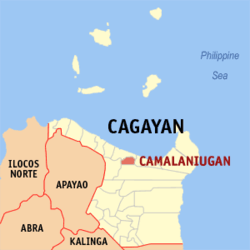Camalaniugan, Cagayan
| Camalaniugan | ||
|---|---|---|
| Municipality | ||
| ||
 Map of Cagayan showing the location of Camalaniugan | ||
.svg.png) Camalaniugan Location within the Philippines | ||
| Coordinates: 18°16′28″N 121°40′25″E / 18.27444°N 121.67361°ECoordinates: 18°16′28″N 121°40′25″E / 18.27444°N 121.67361°E | ||
| Country | Philippines | |
| Region | Cagayan Valley (Region II) | |
| Province | Cagayan | |
| District | 1st District | |
| Founded | June 15, 1596 | |
| Barangays | 28 | |
| Government[1] | ||
| • Mayor | Isidro T. Cabaddu | |
| Area[2] | ||
| • Total | 76.50 km2 (29.54 sq mi) | |
| Population (2010)[3] | ||
| • Total | 23,404 | |
| • Density | 310/km2 (790/sq mi) | |
| Time zone | PST (UTC+8) | |
| ZIP code | 3510 | |
| Dialing code | 78 | |
| Income class | 4th class | |
Camalaniugan is a fourth class municipality in the province of Cagayan, Philippines. According to the 2010 census, it has a population of 23,404 people.[3]
Barangays
Camalaniugan is politically subdivided into 28 barangays.[2]
{{Columns
- Afunan Cabayu
- Agusi
- Alilinu
- Baggao
- Bantay
- Bulala
- Casili Norte
- Catotoran Norte
- Centro Norte (Pob.)
- Centro Sur (Pob.)
- Cullit
- Dacal-Lafugu
- Dammang Norte
- Dugo
- Fusina
- Batalla
- Jurisdiction
- Luec
- Minanga
- Paragat
- Tagum
- Tuluttuging
- Ziminila
- Casili Sur
- Catotoran Sur
- Dammang Sur (Felipe Tuzon)
- Sapping
}}
History
The town was named after the "malaniug" trees which grew in abundance during the early years.
Camalaniugan was founded on June 15, 1596, a rather early date because of its proximity to Nueva Segovia (Lallo). San Jacinto de Polonia was selected as their patron saint. The early settlers were the Ybanags and Ilocanos, both peace-loving citizens. They built their houses along the banks of the Cagayan River. They brought with them their knowledge of farming and skills in making weapons. According to the story related by the elders, among these "happy" settlers was Guiab, a famous strongman and leader of Camalaniugan. He did not like the missionaries. Because of this, he was arrested and later hanged from a malaniug tree by order of Juan Pablo Carreon. For years the people suffered injustice.
Between the year 1887-1888, Fray Marcelino Cascos, O.P., built a convent. It was in this convent where Col. Daniel Tirona billeted his men after arresting the missionaries when he occupied the town in 1898.
It is in this town where the oldest Christian bell in the Far East is located. It is also the birthplace of Don Vicente Nepomuceno, author of the history book "Historia Nac Cagayan" which is written in Ybanag.
The town has a church dedicated to San Jacinto or Saint Hyacinth which houses the oldest church bell (Sancta Maria, 1595) in the far east.
Demographics
| Population census of Camalaniugan | ||
|---|---|---|
| Year | Pop. | ±% p.a. |
| 1990 | 11,222 | — |
| 1995 | 19,915 | +11.35% |
| 2000 | 21,186 | +1.34% |
| 2007 | 22,489 | +0.83% |
| 2010 | 23,404 | +1.46% |
| Source: National Statistics Office[3] | ||
References
- ↑ "Official City/Municipal 2013 Election Results". Intramuros, Manila, Philippines: Commission on Elections (COMELEC). 11 September 2013. Retrieved 24 January 2014.
- ↑ 2.0 2.1 "Province: CAGAYAN". PSGC Interactive. Makati City, Philippines: National Statistical Coordination Board. Retrieved 24 January 2014.
- ↑ 3.0 3.1 3.2 "Total Population by Province, City, Municipality and Barangay: as of May 1, 2010" (PDF). 2010 Census of Population and Housing. National Statistics Office. Retrieved 24 January 2014.
External links
 |
Aparri |  | ||
| Allacapan | |
Buguey | ||
| ||||
| | ||||
| Lal-Lo |
| ||||||||||||||||||
